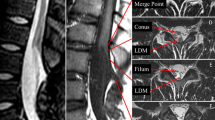Abstract
Purpose
The term limited dorsal myeloschisis (LDM) was used by Pang et al. (2010) to describe a distinct clinicopathological entity. LDMs are characterized by two invariable features: a focal-closed neural tube defect and a fibroneural stalk that links the skin lesion to the underlying spinal cord.
Methods
We retrospectively analyzed the neurosurgical pathologic findings of four LDM patients.
Results
Case 1 had a saccular skin lesion with nonterminal abortive myelocystocele at T11–12. Cases 2, 3, and 4 had a non-saccular (flat) skin lesion in the lumbosacral region. The morphologic features of the lesion in case 2 were those of meningocele manque. Cases 3 and 4 had accompanying non-LDM anomalies, caudal-type lipoma and type II split-cord malformation with neurenteric cyst, respectively. At preoperative diagnosis of the LDM stalk, magnetic resonance imaging, including 3D heavily T2-weighted image was useful; however, minute findings were often missed in the complicated cases 3 and 4. All patients had a favorable outcome following untethering of the stalk from the cord. The central histopathological feature of the LDM stalk is neuroglial tissue in the fibrocollagenous band; however, the stalk in cases 2 and 4 did not have glial fibrillary acidic protein-immunopositive neuroglial tissues.
Conclusions
Therefore, the diagnosis of LDM should be made based on comprehensive evaluation of histologic and clinical findings.





Similar content being viewed by others
References
Chatterjee S, Rao KSM (2015) Missed limited dorsal myeloschisis: an unfortunate cause for recurrent tethered cord syndrome. Childs Nerv Syst 31:1553–1557
Eibach S, Moes G, Hou YJ, Zovickian J, Pang D (2017) Unjoined primary and secondary neural tubes: junctional neural tube defect, a new form of spinal dysraphism caused by disturbance of junctional neurulation. Childs Nerv Syst 33:1633–1647
Hashiguchi K, Morioka T, Fukui K, Miyagi Y, Mihara F, Yoshiura T, Nagata S, Sasaki T (2005) Usefulness of constructive interference in steady-state (CISS) MR imaging in the presurgical examination for lumbosacral lipoma. J Neurosurg (6 Pediatrics) 103:537–543
Hashiguchi K, Morioka T, Yoshida F, Miyagi Y, Mihara F, Yoshiura T, Nagata S, Sasaki T (2007) Feasibility and limitation of constructive interference in steady-state (CISS) MR imaging in neonates with lumbosacral myeloschisis. Neuroradiology 49:579–585
Lassman LP, James CC (1977) Menigocele manque. Child’s Brain 3:1–11
Lee JY, Chong S, Choi YH, Phi JH, Cheon J-E, Kim S-K, Park SH, Kim I-O, Wang K-C (2017) Modification of surgical procedure for “probable” limited dorsal myeloschisis. J Neurosurg Pediatr 19:616–619
Lee SM, Cheon J-E, Choi YH, Kim I-O, Kim WS, Cho H-H, Lee JY, Wang K-C (2017) Limited dorsal myeloschisis and congenitall dermal sinus: comparison of clinical and MR imaging features. AJNR Am J Neuradiol 38:176–182
Morioka T, Hashiguchi K, Yoshida F, Nagata S, Miyagi Y, Mihara F, Sasaki T (2007) Dynamic morphological changes in lumbosacral lipoma during the first months of life revealed by constructive interference in steady-state (CISS) MR imaging. Childs Nerv Syst 23:415–420
Morioka T, Murakami N, Shimogawa T, Mukae N, Hashiguchi K, Suzuki SO, Iihara K (2017) Neurosurgical management and pathology of lumbosacral lipomas with tethered cord. Neuropathology 37:385–392
Morota N, Ihara S, Ogiwara H (2017) New classification of spinal lipomas based on embryonic stage. J Neurosurg Pediatr 19:428–439
Murakami N, Morioka T, Hashiguchi K, Yoshiura T, Hiwatashi K, Suzuki SO, Nakamizo A, Amano T, Hata N, Sasaki T (2013) Usefulness of three-dimensional T1-weighted spoiled gradient-recalled echo and three-dimensional heavily T2-weighted images in preoperative evaluation of spinal dysraphism. Childs Nerv Syst 29:1905–1914
Murakami N, Morioka T, Ichiyama M, Nakamura R, Kawamura N (2017) Lateral lipomyelomenigocele of the hemicord with split cord malformation type I revealed by 3D heavily T2-weighted MR imaging. Childs Nerv Syst 33:993–997
Muthukumar N, Arunthathi J, Sundar V (2000) Split cord malformation and neurenteric cyst-case report and a theory of embryogenesis. Br J Neurosurg 8:586–587
Pang D, Mark DS, Mamdouha A-B (1992) Split cord malformation: part 1: a unified theory of embryonesis for double spinal cord malformation. Neurosurgery 31:451–458
Pang D (1993) Cervical myelomanigoceles. Neurosurgery 33:363–373
Pang D, Zovickian J, Oviedo A, Moes GS (2010) Limited dorsal myeloschisis: a distinctive clinicopathological entity. Neurosurgery 67:1555–1580
Pang D, Zovickian J, Wong S-T, Hou YJ, Moes GS (2013) Limited dorsal myeloschisis: a not-so-rare form of primary neurulation defect. Childs Nerv Syst 29:1459–1484
Rossi A, Piatelli G, Gandolfo C, Pavenello M, Hoffmann C, van Goethem JW, Cama A, Tortori-Donati P (2006) Spectrum of nonterminal myelocystoceles. Neurosurgery 58:509–515
Schmidt C, Bryant E, Iwanaga J, Oskouian RJ, Oakes WJ, Tubbs RS (2017) Menigocele manque: a comprehensive review of this enigmatic finding in occult spinal dysraphism. Childs Nerv Syst 33:1065–1071
Acknowledgements
This work was partly supported by Research Foundation of Fukuoka Children’s Hospital. We thank Denise Di Salvo, MS, from Edanz Group (www.edanzediting.com/ac) for editing a draft of this manuscript.
Author information
Authors and Affiliations
Corresponding author
Ethics declarations
Conflict of interest
The authors declare that they have no conflict of interest.
Rights and permissions
About this article
Cite this article
Morioka, T., Suzuki, S.O., Murakami, N. et al. Neurosurgical pathology of limited dorsal myeloschisis. Childs Nerv Syst 34, 293–303 (2018). https://doi.org/10.1007/s00381-017-3625-5
Received:
Accepted:
Published:
Issue Date:
DOI: https://doi.org/10.1007/s00381-017-3625-5




